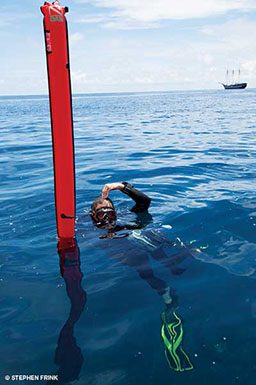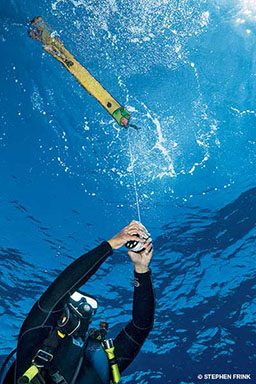Note: This article is designed to offer tips for better deployment of surface marker buoys from depth. This is a skill that should be practiced under the guidance of a qualified instructor.
Surface marker buoys (SMBs) are designed to be inflated at depth and sent to the surface at the end of a line. By inflating an SMB at depth a dive team marks their position at the beginning of their ascent, allowing them to perform a safety stop or required decompression while the boat maneuvers into position. In theory, this minimizes the amount time divers must spend on the surface waiting to be picked up and maximizes their visibility — and thus, safety.
Divers generally deploy SMBs while neutrally buoyant in the water column, so they must take care not to drop the reel or finger spool, which may be negatively buoyant. There should be at least 50 percent more line on the reel than the depth from which the SMB is being deployed. Before deploying an SMB, look up to make sure the boat hasn’t already found you or that a group of divers isn’t directly overhead. A tiny puff of gas is generally sufficient to keep an SMB upright and makes it easier to manage by preventing it from ascending too quickly.

Some SMBs have overpressure valves (OPVs), which relieve pressure as the buoy ascends and the gas inside it expands. OPVs are generally one-way valves that won’t dump gas once the SMB is on the surface. SMBs with open bottoms do not require OPVs; however, these will dump air if they fall over.
Some divers use a dedicated low-pressure hose with an air tool attachment, but this equipment is probably unnecessary unless you plan to inflate an SMB or a lift bag on every dive. Aside from this dedicated piece of gear there are three basic methods for inflating SMBs, and each has its pros and cons. Whichever technique you choose will require training and practice. Be neutrally buoyant and well trimmed before you begin.
- Inflate the bag by exhaling into the opening. Without removing your regulator, turn your head to direct exhaled bubbles into the SMB’s opening. There is a risk of the line tangling in the regulator and pulling it from your mouth. It may be challenging to get enough gas into the SMB to keep it fully inflated on the surface, but there is little chance of the regulator free flowing, and not much gas should be wasted. This technique requires the SMB to be very close to the diver’s face and thus may limit vision.
- Use your alternate air source. This technique can deliver a large amount of gas into the SMB quickly, but there is a risk of free flow. Since SMBs are usually sent to the surface near the end of dives, excessive loss of breathing gas may be problematic. It is important to secure the alternate air source once the SMB is on its way to the surface to reduce the risk of entanglement of the line around the second stage. Divers should not use their primary second-stage to inflate an SMB, because a problem during deployment could leave the diver without readily available breathing gas.
- Use your BCD’s power inflator. This method will work only if you use a standard inflator; a unit with a built-in alternate air source may be too large to use. Grasp the power inflator, and place it in the SMB, keeping the inflator higher than the BCD’s air bladder(s). Press the inflate and deflate buttons at the same time. This will inflate the SMB quickly, there is little risk of free flow, and the breathing cycle will not be uninterrupted. This method should not affect buoyancy, but if it does the solution is in the diver’s grasp. It is also unlikely to cause entanglement, and there is nothing to reset or replace afterward.

Once the SMB starts its ascent, the reel or finger spool will unwind rapidly; do not allow the line to leave the reel so fast that it creates loops or causes a backlash or a jam. Keep the reel in front of you so you can manage it easily — don’t imitate a subway-strap hanger. Use your free hand as a brake or drag. As soon as the line stops, reel in the slack, and maintain tension. This will keep the SMB upright and give it a better chance of being seen. If you’re using an open-bottom SMB, reel in the slack quickly so the buoy doesn’t dump air and sink. If the SMB can be seen from depth and most of it is still underwater, it will be difficult to spot on the surface. To ensure the SMB stays upright, maintain tension on the line by reeling it in as you ascend.
As you deploy the SMB, your buddy should keep an eye on you and have a cutting tool handy; this minimizes the risk of being dragged to the surface in the event of entanglement. He or she should also monitor the depth. Finally, if added visibility is warranted, your buddy may clip a second SMB to the same line and send it to the surface.
Shooting an SMB is an essential skill for technical divers, those who dive offshore or in current and any divers who might need to mark their location. Pick a method of deployment that works for you, and practice, practice, practice.
The Reel Deal
By Brian Wake
Here are some tips for preparing a new reel for use.
- Tie off the end of the line, and let it out to its full length. Check the line for snags, breaks and defects.
- Use a permanent black marker to make a quarter-inch-wide mark on the line every 10 feet. This will help you monitor your depth as you ascend.
- At 15 feet from the end of the line, use a red marker to mark every foot for five feet, establishing a safety-stop zone between 15 and 20 feet.
- Rewind the line while maintaining tension to ensure it does not catch or snag.
- Use a permanent marker to identify your reel; many reels look alike.
Periodically unwind and rewind your reel to make sure the line has not been damaged, especially if you lend it to someone. It is better to replace a damaged line than to try to make a repair. Routine maintenance will give you confidence that the reel will function properly when you need it.
© Alert Diver — Q2 Spring 2014